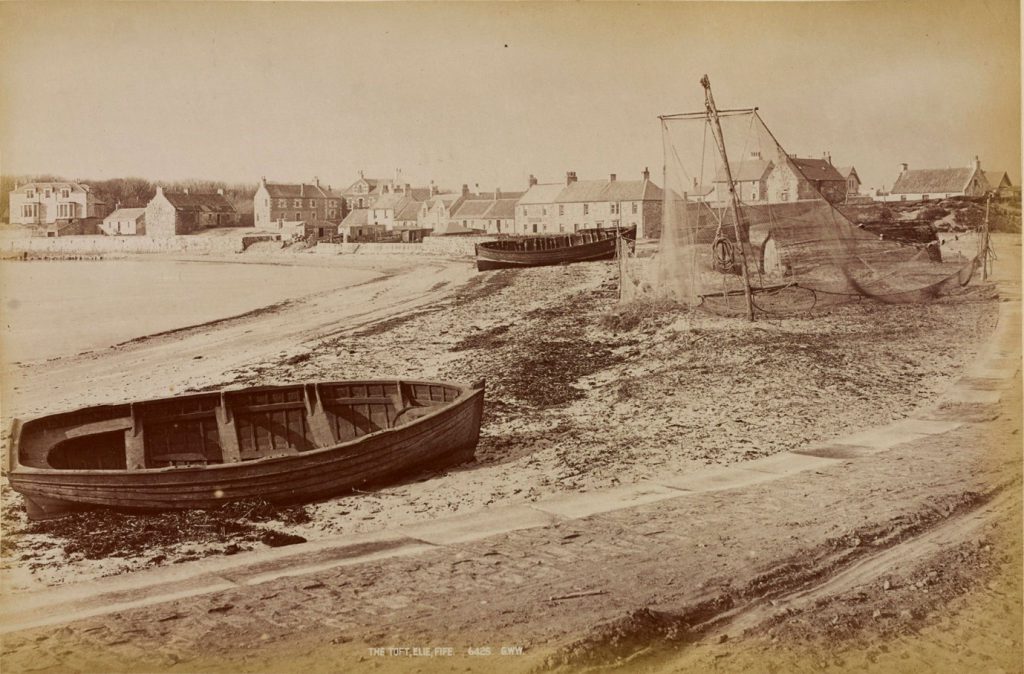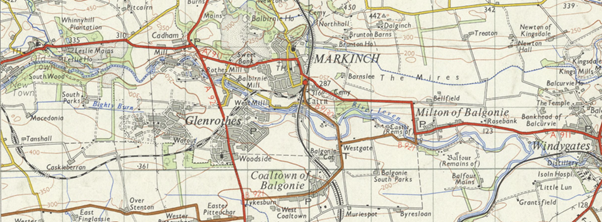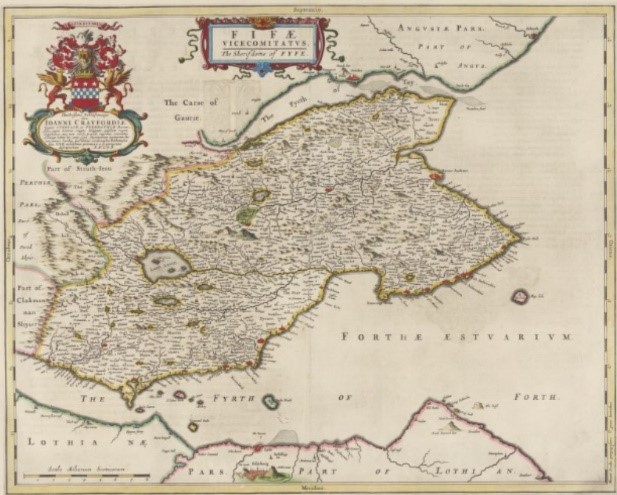Collated by Peter Findlay.
Aince a muckle pairt o Scotland’s industrial hertlaund, I recently heard “Fife” cried, “Scotland’s enchanting kingdom.” Ye micht be gast frae this nameliheid, hooiver, juist hae anither keek at this region afore makin judgement. For at truly is a pairt o oor country, whaur baith Fifers and veesitors alike, can gang on a byous an timeless journey o discovery.
Believe me, ye can veesit places thit’ll spairk up the imaigination, mak the mynd cantie and leave fowk open moothed in puir admiration.
Forby this, mony a weel-kenned line haes been played, scrieved, sung and spoken anent the launds an watters o Fife, wae mony a picture o the harbours and laundscapes being pentit or captured on film anaw. At’s also very clear, gangin by the recent rich seam o talent, wha hiv contributit thair ain special pairts intae Fife’s story, thit the “Kingdom’s” high repute wilna dwyne ony time soon.
The qualities, which inspire sae mony fowk, and whit mak this region sae faur ben, must surely be ats unique blend o ancient an important touns an havens. These are locatit in quite a diverse laundscape, an alang a coastline o sic natural beauty, which fowk share wae a thriving variety o plant an wildlife. This includes aw manner o birdies, red squirrel, wild deer, seals, whales and dolphins. An at’s aw juist a swith journey frae fower o Scotland’s major cities.
Fife is indeed, a wallie-gowdie in Scotia’s croun.
Where to find local collections:
Fife Council Local Studies Collections, with ON centres in Cupar, Dunfermline, Kirkcaldy and Methil, and Library and Heritage Centres at Inverkeithing, Newburgh and Newport.
https://onfife.com/libraries-archives/family-and-local-history/local-studies-collections
Fife Archives, Glenrothes
http://onfife.com/libraries-archives/archives/your-visit
Forby these, ye can veesit the wabsicht o the National Library of Scotland. Here’s a wee taste o some digital haudins anent Fife and ats fowk.
Books – non fiction
Today, Pittenweem is a picturesque fishing village in Fife’s, East Neuk. But in the 18th Century this was a place of suspicion and witch trials. Read, “the Weem Witch” by Leonard Low.
https://search.nls.uk/permalink/f/sbbkgr/44NLS_ALMA21564431150004341
Read more about the ‘Pittenweem Witches’ in this auld chapbook:
There’s mair tae Kirkcaldy than a ‘queer-like smell.’ The ‘lang toun’ was the birthplace of the philosopher, Adam Smith (1723-1790). Smith’s contribution to the Scottish Enlightenment included his work, “The Theory of Moral Sentiments”
Read the full text online:
https://search.nls.uk/permalink/f/sbbkgr/44NLS_ALMA51595199450004341
Books – fiction
Fifer and bestselling author of crime fiction, Val McDermid.
Val waes born in Kirkcaldy anaw, and still maintains strang links wae the place, including her support for the fitbaw team, Raith Rovers. The likes of former Prime Meenister, Gordon Brown, Ian Rankin and his neebor, Inspector Rebus are among other high profile supporters o “The Rovers.”
The National Library of Scotland is not just for academic researchers and research. If you wish to read the first three books in Val’s No.1 bestselling crime series, featuring clinical psychologist, Dr Tony Hill (of ‘Wire in the Blood’ fame).
The books are here:
https://search.nls.uk/permalink/f/sbbkgr/44NLS_NPLD_EBK017605297
Also, a body’s discovered in the Firth o Forth by a fisherman. Read, ‘Still Life’ here:
https://search.nls.uk/permalink/f/sbbkgr/44NLS_NPLD_EBK019801450
Film
Films from the Moving Image Archive, showcasing Fife’s social and industrial past, featuring scenes from Buckhaven and Methil, on the Firth o Forth, and Newburgh, on the Firth o Tay:
https://movingimage.nls.uk/film/3640
https://movingimage.nls.uk/film/N0645
Manuscript collection
Another great author, Ian Rankin, was born in the former Fife mining toun o Cardenden and attended Beath High School, Cowdenbeath. The crime writer, most famous for his novels featuring Inspector Rebus, donated his archive to the National Library of Scotland in 2019. This archive is now available for public consultation.
View the inventory here: https://manuscripts.nls.uk/repositories/2/resources/20273
Maps
“The Sherrifdom of Fife,” as portrayed in the, “Blaeu Atlas of Scotland, 1654.” View in greater detail, at: https://maps.nls.uk/atlas/blaeu/browse/92
See what’s changed and what hasn’t, in Fife. Using a ‘side by side’ view we can explore what has happened in the Fife landscape over the last century:
The Fife Coastal Path follows the coastline of eastern Scotland for 117 miles (187 km) from Kincardine on the Forth to Newburgh on the Tay.
Check out the route in this guide book,
https://search.nls.uk/permalink/f/sbbkgr/44NLS_ALMA21497740250004341
An e-resource, from University of St.Andrews
The Records of the Parliaments of Scotland to 1707 (RPS) is a fully searchable database containing the proceedings of the Scottish parliament from the first surviving act of 1235 to the union of 1707. The culmination of over ten years’ work by researchers from the Scottish Parliament Project based in the School of History at the University of St Andrews, the online edition seeks to make this key historical source freely available to all in a technologically advanced and user-friendly format. https://www.rps.ac.uk/
A business
Nairn’s linoleum factory in Kirkcaldy, a film focusing on the manufacturing processes involved https://movingimage.nls.uk/film/4325 and a design from a Nairn’s linoleum catalogue, 1955. Part of the library’s, ‘Wha’s like us’ exhibition: https://www.nls.uk/exhibitions/whas-like-us/l
Linoleum is still developed and produced in Kirkcaldy, all be it, on a far smaller scale than in its heyday.
A person
Kenny Anderson, the singer-songwriter and composer goes by the stage name, ‘King Creosote’ and lives in Fife’s, ‘East Neuk.’ Kenny wrote and produced a great soundtrack to the archive film, ‘From Scotland With Love,’ directed by Virginia Heath. The film features over a hundred film clips from the National Library of Scotland’s, Moving Image Archive. You can learn a bit more about this collaboration by visiting:
https://www.nls.uk/collections/moving-image-archive
A song or piece of music
The “East Neuk o Fife,” is a weal kent air and Alexander Boswell (1775-1822) used the tune tae accompany his humorous sang, “Auld Gudeman.”
Alexander was the son of James Boswell, the friend and biographer of Samuel Johnson. Alexander was also an antiquarian, a poet and writer, who became a friend of Sir Walter Scott. His life ended prematurely when he was shot in a duel and died from his wounds at Auchtertool, near Kirkcaldy.
https://digital.nls.uk/special-collections-of-printed-music/archive/94651812
The words could be the inspiration for The Pogues’ ‘Fairytale of New York.’ It records the lyrical argy-bargy between a married couple of twenty years. Although they do appear to have made up by the end of the song.
https://digital.nls.uk/special-collections-of-printed-music/archive/94651800
A ghost/mythical creature
The Giant Skate o Crail. This muckle creature is said to have been landed in the fisher haven o Crail, but it wouldna dee. Just one of the stories in Fife Folk Tales, by Sheila Kinninmonth
https://search.nls.uk/permalink/f/1jc5lod/44NLS_NPLD_EBK018161942
A castle or other historic building
Dunfermline Abbey Church dates back to the 11th Century. The church is first mentioned upon the marriage of King Malcolm III and Queen Margaret, later St. Margaret. Their son, David I, founded Dunfermline Abbey in 1128 and it became well established as a prosperous royal mausoleum for the Scottish monarchy. A total of eighteen royals, including seven Kings, were buried here from Queen Margaret in 1093 to Robert Stewart, Duke of Albany in 1420. Robert I (The Bruce) became the last of the seven Scottish Kings to be buried here, in 1329.
Fowk ayeweys speir, why at’s cried, the “Kingdom o Fife?”
Truth be telt, we must go back tae a time afore the royal faimlies o the Scots. At’s mair than likely that Fife waes an auld kingdom o the Pechts, or Picts, wha bidit in whit waes knawn as ‘Fib,’or the associated ‘Fothriff.’ Sae at’s the Pechtish kings, or queens, wha likely gied Fife the status o an actual ‘kingdom.’ The Pechts left a legacy in their mony place names. These stairtit, ‘Pett’ or ‘Pit,’ meaning a share, or portion o land, and there are many extant places, frae Pittencrieff Pairk, in Dunfermline, tae Pittenweem, in Fife’s East Neuk, as examples. Indeed, numerous important archaeological sites in the Fife region suggest it waes a place whaur Pechtish culture flourished.
Mebbe wishing tae follae tradition, at cam aboot that Fife waes faur ben wae the royal faimlies o the Scots. Ootby, they’d gang on horseback, hunting the deer or boar thit bidit in the forests. Queensferry gies us a clue whaur an important crossin ower the Forth waes made. Boarhills, mebbes a royal huntin grund and Kingsbarns, whaur the livestock an crops belonging tae the monarch waur tae be kept an stored.
King Alexander III went tapsalteerie tae his deith in a great storm, richt ower the cliff at Kinghorn. Forby this, thare waur the royal palaces at Dunfermline and Falkland and mony a monarch made a pilgrimage tae thair royal burgh o St. Andras.
St.Andrews Cathedral haes been the centre o Christian Scotland syne the 12th century.
Food
Fife’s seafood is renowned and still blesses the tables of many fine dining establishments. E’en if ye’re na a millionaire, what can beat a guid fish supper at the seaside?
The days o the siller darlins (herring) micht hae passed. Nooadays, the fisher boats setting oot frae Fife’s numerous havens hae drastically reduced in number, especially when compared to the days o the ‘fifie’ and the steam trawler. Hooiver there’s still plenty o sea fare tae be enjoyed in the fisher touns up an aboot the Fife Coast.
Here’s some auld recipes for cooking fish and shellfish frae the National library of Scotland’s archives: https://digital.nls.uk/recipes/themes/fish/index.html
Photograph
An auld photograph of Elie shore, from the ‘MacKinnon Collection.’
Ye can see cricket matches played on Elie beach nooadays. Wunner what the auld fisher fowk wid mak o a, “Howzat?”
Mair coastal images anent Fife can be viewed at: https://digital.nls.uk/learning/from-shore-to-shore/

Something about the county town
Glenrothes is the administrative centre for Fife. Planned as one of Scotland’s first ‘New Towns’ after WWII, building began on Glenrothes in the late 1940s. Initially to house a growing workforce employed in coalmining, the town was planned around the Leslie-Markinch area. The town quickly grew from massive state investment in the Scottish coal industry, with the Rothes Colliery opening in 1957. The OS maps from 1948, show the Leslie-Markinch area prior to the town’s foundation: https://maps.nls.uk/joins/10521.html
Also, a 1969 film describes the benefits of Scottish New Town planning and building:
https://movingimage.nls.uk/film/1826
The town’s development over the years has received mixed reviews. In 2009, Glenrothes was awarded a “Carbuncle Award” in the most dismal place in Scotland category. This was for the state of its, “depressed and investment starved town centre.” Paradoxically, between 2010 and 2014, the town received various awards for both cleanliness and beauty. A real ‘ugly duckling’ story.
Today, the people of Glenrothes enjoy employment in a good range of services, manufacturing and engineering jobs, which includes a recently opened malt whisky distillery.
Something about a village or small place
Culross, pronounced ‘Coorus,’ is a bonny wee coastal village upo the Firth o Forth. The village is said to have been founded by St. Serf in the 6th Century. It also has a palace, and Culross Abbey was founded in 1217 by Malcolm, Earl of Fife: https://digital.nls.uk/slezer/engraving/?sl=48
Also, watch this 1955 film of a day trip to Culross. It’s a brilliant amateur film, capturing the built heritage of the village. Also, some good shots of afternoon tea before the main event:
https://movingimage.nls.uk/film/6824
Further Reading
Memoirs and Adventures of Sir William Kirkcaldy of Grange by James Grant, 1849.
A Fifer, politician and soldier, William Kirkcaldy of Grange (1520-1573) held Edinburgh Castle for Mary, Queen of Scots during the ‘Lang Siege’ (1571-1573). He was executed for his loyalty to the queen after the siege was ended. https://search.nls.uk/permalink/f/19q5vbt/44NLS_ALMA21431722850004341
https://digital.nls.uk/dcn23/9553/95537744.23.pdf
A Twelvemonth and a day by Christopher Rush, 2010?
A fascinating story about a young boy growing up in a small fishing/farming community.
https://search.nls.uk/permalink/f/1jc5lod/44NLS_NPLD_EBK019111863

